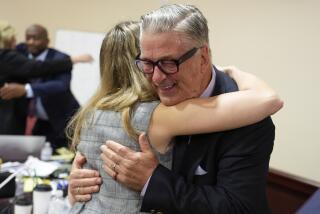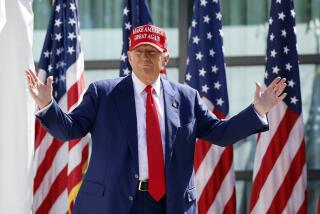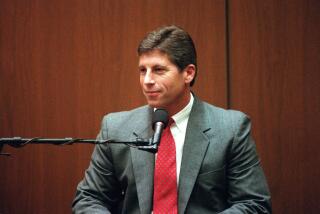Ito Bars Some Querying of Key LAPD Detective : Simpson case: Some of Fuhrman’s alleged remarks may not be used by defense to attack his credibility.
- Share via
O.J. Simpson’s lawyers will not be allowed to question Los Angeles Police Detective Mark Fuhrman about racist remarks that he allegedly made in connection with a 1981 pension case or about claims that he moved evidence in a 1988 police shooting, Superior Court Judge Lance A. Ito ruled Friday.
Ito added, however, that he may allow the defense team to question the detective about comments that a real estate agent said he made to her in 1985 or 1986 at a Marine Corps recruiting station in Redondo Beach. That agent, Kathleen Bell, said in a sworn declaration that Fuhrman derided blacks and said he would manufacture evidence if it would implicate an interracial couple.
Through his lawyer, Fuhrman has adamantly denied being a racist or making the remarks that Bell attributed to him. His credibility has come under assault for months as defense lawyers have sought to undermine his testimony that he found a bloody glove outside Simpson’s home, potentially key evidence because it matches one found at the crime scene and because sources say DNA tests suggest that it is stained with blood from both victims, Nicole Brown Simpson and Ronald Lyle Goldman. Simpson has pleaded not guilty to the June 12 killings.
The judge’s ruling came at the conclusion of a busy court day and was the last major decision standing in the way of opening statements in the Simpson trial. Those are scheduled to begin Monday at 10 a.m.
While ruling for the prosecution in most respects, Ito’s five-page order raised the possibility that Fuhrman will be questioned about his alleged use of a racial epithet in a hotly disputed conversation with Bell. The balance of the judge’s ruling was good news for the prosecution because it prevents the defense from raising questions about a pension case in which city-hired doctors described alleged racist remarks by Fuhrman and noted his tendency to exaggerate--issues that could have eroded his credibility in the jury’s eyes.
“The court does not find there to be a direct link between comments made in approximately 1980 and credibility in 1994,” Ito wrote.
The judge’s order also bars defense attorneys from suggesting that Fuhrman moved evidence in a 1988 police shooting case. That incident sheds no light on Fuhrman’s credibility and the witness’s description of the officer who allegedly was responsible does not even appear to match Fuhrman, the judge said.
*
Although Ito’s order could allow Fuhrman to be questioned about the alleged comments to Bell, the judge did not resolve that issue. He gave defense lawyers until Monday morning to demonstrate the relevance of the exchange and said that if they could do so, he would then allow them to question the detective about the incident--including Fuhrman’s alleged use of a searing racial epithet that the judge and lawyers have taken to describing as “the N-word.”
Possible use of that epithet in court was the subject of the trial’s most gripping exchange earlier this month, when Deputy Dist. Atty. Christopher A. Darden and lead Simpson trial lawyer Johnnie L. Cochran Jr. squared off to debate its potential impact on the largely African American jury.
Ito referred to the “impassioned and heartfelt” debate over the term, but ruled that if the defense can show that the Bell statements are relevant, they can question Fuhrman about them.
“When meritorious arguments are raised on both sides, the court must always remember this process is a search for truth and that it depends on the sound judgment of our jurors,” Ito wrote. “If the challenged racial epithet was used in a relevant incident, it will be heard in court.”
The Fuhrman ruling highlighted a day in which Ito disposed of a number of lingering issues in the case. He issued an order barring witnesses from following news coverage on television, radio or in the newspaper when that coverage pertains to the subject of their testimony. He directed prosecutors to eliminate all references to a number of witnesses from their opening statements. And court officials handed out to an eager pack of journalists seating charts for the coveted spots inside the courtroom--four news organizations and two authors landed prized permanent seats, while others were left grousing.
As lawyers hurried to complete work on the remaining trial issues, they revealed that police have never recovered the shoes that tracked blood from the scene of the murders O.J. Simpson is accused of committing. Instead, prosecutors hope to link Simpson to the shoe prints by demonstrating that he owned a similar pair at one time.
“There are no pairs of shoes that are in Mr. Simpson’s possession, that were found at Mr. Simpson’s house, that match any of the footprints found at any of the crime scenes in this incident,” said Carl Douglas, one of Simpson’s lawyers.
On the prosecution’s latest witness list, they included a number of employees of Bloomingdale’s, and they indicated Friday that they expect some to testify that Simpson purchased, or had purchased for him, a pair of expensive Bruno Magli shoes that would match the pattern found at the crime scene. Simpson’s lawyers protested that they have not had time to research those witnesses.
Ito agreed that the defense deserved more time and ordered the government attorneys to avoid any reference to them in their opening statements. He also directed prosecutors to delay calling the Bloomingdale’s witnesses until the end of their case.
That could affect the prosecution’s presentation, but otherwise creates little difficulty for the government team, especially because the evidence attempting to link Simpson to the shoes, as well as to a pair of Isotoner gloves also purchased at Bloomingdale’s, is considered a relatively minor part of the overall prosecution case. Even if prosecutors can show that Simpson at one time owned gloves or shoes of the types described, thousands of other people do as well, defense sources noted.
Prosecutors did not object to relegating the Bloomingdale’s witnesses to the end of their case.
They did balk when Ito ordered them to postpone calling a number of witnesses connected to the domestic abuse portion of their case. Some of those witnesses were discussed during hearings this month, and Darden said delaying their testimony and deleting them from opening statements would force a “big change in the prosecution strategy.”
*
Ito was unmoved. His ruling will prevent prosecutors from mentioning some of the domestic abuse allegations in their opening statements but will not block them from discussing most of that evidence and will not stop them from calling the other witnesses once the defense has had the opportunity to research them.
As both sides debated a number of minor issues that need to be disposed of before opening statements can begin Monday, prosecutors revealed that they have another witness who may testify about alleged domestic abuse, and defense lawyers asked Ito to reconsider his decision not to instruct the jury that it must find Simpson guilty “to a moral certainty” if it decides to convict him.
Ito told the lawyers Thursday that he intends to delete that language from the instructions to the jury, requiring the panel only to find Simpson guilty if the evidence supports that verdict “beyond a reasonable doubt.”
But Douglas asked the judge to consider a compromise, keeping the “moral certainty” language but deleting another section of the jury instructions that refers to “moral evidence.”
Defense attorneys appeared unperturbed by the prosecution’s latest addition to its growing list of domestic violence allegations against Simpson. According to sources, the new witness, Yocanda Redfern, cared for the Simpsons’ children in the early 1990s, and came forward to prosecutors recently. Among other things, she said Nicole Simpson carried Mace, suggesting that she might have done so because she feared for her safety.
Simpson was in court when a one-page sheet detailing Redfern’s allegations was distributed to his lawyers and the judge. He laughed softly and shook his head as he read it.
“What we saw in that report is much ado about nothing,” Cochran said later.
At the close of the court day, Ito distributed a seating chart for the trial, divvying up 24 press seats among news organizations from around the world that have clamored to cover the proceedings. Four organizations--The Times, the Daily News of Los Angeles, the Associated Press and City News Service--all landed permanent seats, as did authors Joe McGinnis and Dominick Dunne.
Others were relegated to watching on television or to sharing seats. The New York Times and La Opinion, for instance, will split one seat, while another seat will rotate among several lesser-known and foreign outlets.
Disappointed journalists bemoaned their fate as the seating chart was distributed. But for the lucky few, there was elation: “I got a great seat,” exclaimed City News Service reporter Shoreen Maghame, gripping her copy of the chart.
The Simpson Case
* A package of photos, articles, and other background information on the O.J. Simpson trial is available from TimesLink, the new on-line service of the Los Angeles Times.
Details on Times electronic services, A5.
More to Read
Sign up for Essential California
The most important California stories and recommendations in your inbox every morning.
You may occasionally receive promotional content from the Los Angeles Times.













